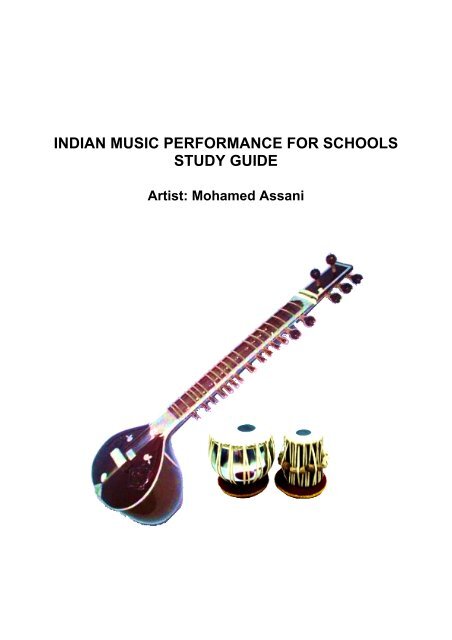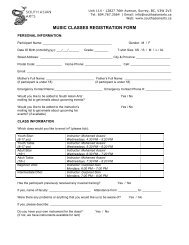about the artist - Mohamed Assani
about the artist - Mohamed Assani
about the artist - Mohamed Assani
Create successful ePaper yourself
Turn your PDF publications into a flip-book with our unique Google optimized e-Paper software.
INDIAN MUSIC PERFORMANCE FOR SCHOOLS<br />
STUDY GUIDE<br />
Artist: <strong>Mohamed</strong> <strong>Assani</strong>
ABOUT THE ARTIST: MOHAMED ASSANI<br />
<strong>Mohamed</strong> <strong>Assani</strong> is a celebrated sitarist and<br />
tabla player with a unique sound. He is<br />
widely known for his au<strong>the</strong>ntic raga<br />
performances as well as his creative ability<br />
to adapt his instrument to different genres,<br />
including Western Classical, Jazz & World<br />
Fusion.<br />
Apart from his Indian Classical work,<br />
<strong>Mohamed</strong> has also worked with some<br />
leading Western musicians, including<br />
contemporary composer Ian Wilson, <strong>the</strong><br />
Callino Quartet, <strong>the</strong> Grand Union Orchestra<br />
and <strong>the</strong> Black Dyke Brass Band. His band,<br />
Indus, (featuring sitar, santoor, Western flute<br />
and tabla) has received critical acclaim for<br />
<strong>the</strong>ir original music including being hailed as<br />
'ones to keep a beady eye upon' by <strong>the</strong> UK's<br />
award-winning froots magazine.<br />
<strong>Mohamed</strong> has also taken his music to <strong>the</strong> stage, composing and performing for<br />
acclaimed playwright Rani Moorthy's 'Dancing within Walls' and a production of Kipling's<br />
'The Man Who Would be King.'<br />
<strong>Mohamed</strong>'s musical journey began at Dartington College of Arts in England, where he<br />
did a degree in Western Classical and World music. Through a combination of fate and<br />
chance, he later switched from piano to sitar as his main instrument. <strong>Mohamed</strong> began<br />
his training on <strong>the</strong> sitar from Sri Dharambir Singh and later learned from Sri Mehboob<br />
Nadeem. He is now a disciple of Ustad Ashraf Sharif Khan of <strong>the</strong> Poonch<br />
Gharana. <strong>Mohamed</strong> plays sitar in <strong>the</strong> emotive style developed by <strong>the</strong> late Ustad Vilayat<br />
Khan, in which <strong>the</strong> sitar is made to emulate <strong>the</strong> human voice through bending its strings.<br />
As a dedicated and experienced teacher, <strong>Mohamed</strong> has inspired students of all ages in<br />
<strong>the</strong>ir musical journeys. During his extensive teaching career, he has taught at <strong>the</strong> Royal<br />
Academy of Music (London, England), <strong>the</strong> University of Huddersfield and <strong>the</strong> BRIT<br />
School of Performing Arts (London, England). He currently teaches at <strong>the</strong> VSO School<br />
of Music in Vancouver, Canada.<br />
GET IN TOUCH:<br />
Cell: (604) 354-9869<br />
Email: info@mohamedassani.com<br />
Web: www.mohamedassani.com<br />
Electronic Press Kit: www.sonicbids.com/mohamedassani
ABOUT THE PERFORMANCE<br />
<strong>Mohamed</strong> <strong>Assani</strong> is a professional sitarist, tabla player and trained teacher. For schools,<br />
he will present a 45-minute performance, which will include <strong>the</strong> following elements:<br />
1. Sitar Performance (Approx 13 mins)<br />
<strong>Mohamed</strong> will present a raag (melody) and a folk tune on <strong>the</strong> sitar. <strong>Mohamed</strong> will also<br />
explain a bit <strong>about</strong> <strong>the</strong> instrument and how it works.<br />
2. Tabla Performance (Approx 10 mins)<br />
<strong>Mohamed</strong> will present a short performance on <strong>the</strong> tabla. This will be followed by a<br />
recitation of bols (language of <strong>the</strong> tabla) followed by a performance of <strong>the</strong> bols on tabla.<br />
3. Live Performance Creation – Technology (Approx 12 mins)<br />
<strong>Mohamed</strong> is developing a unique live performance for schools, that allows students to<br />
experience what a live performance of sitar and tabla sounds like. (Normally, sitar and<br />
tabla are performed toge<strong>the</strong>r by two musicians in a concert.) He will do a live recording<br />
on each of his instruments (keyboard, tabla, sitar) in front of students. He will <strong>the</strong>n play<br />
back <strong>the</strong> recording and perform on top of it to create a layered performance featuring<br />
keyboard, tabla and sitar. This gives <strong>Mohamed</strong> <strong>the</strong> opportunity to showcase all his<br />
skills as a multi-instrumentalist. Plus, students will have <strong>the</strong> opportunity to experience<br />
how a performance is built, <strong>the</strong> different elements and <strong>the</strong> final outcome.<br />
4. Interactive Session with Q & A (Approx 10 mins)<br />
<strong>Mohamed</strong> will open up to a question period and, where appropriate, do some<br />
interactive exercises with students. <strong>Mohamed</strong> will also share a bit <strong>about</strong> his<br />
experience and ethos as a musician.
INSTRUMENTS USED IN THE PERFORMANCE<br />
SITAR<br />
The sitar is <strong>the</strong> most popular melodic instrument in classical nor<strong>the</strong>rn Indian music today.<br />
Toge<strong>the</strong>r with <strong>the</strong> Surbahar and <strong>the</strong> Tanpura, it is part of <strong>the</strong> family of long-neck lutes. The<br />
large gourd is made of a dried pumpkin. The neck is usually made of aged Tun wood, an<br />
Indian variety of teakwood. Metal strings made of steel (bass strings also of brass or<br />
bronze) run across two bridges made of bone. The frets are movable by cords that are tied<br />
to <strong>the</strong> neck and are also made of steel. The word “sitar” comes from Iran and means<br />
“three strings.” “Seh” means three and “Tar” means string.<br />
TABLA<br />
The Tabla is regarded as <strong>the</strong> queen of drums and percussion instruments and is <strong>the</strong> most<br />
popular Indian rhythm instrument. It consists of two drums: <strong>the</strong> Bayan (big bass drum) and<br />
<strong>the</strong> Dayan. The two of <strong>the</strong>m are almost always played toge<strong>the</strong>r. Both drums have a body<br />
that is closed at <strong>the</strong> bottom. The open top is usually covered with a goat lea<strong>the</strong>r skin. To<br />
<strong>the</strong> edge of this basic skin, a second skin (Kani) is attached. In <strong>the</strong> centre of <strong>the</strong> skin is <strong>the</strong><br />
GAB: a black area that gives <strong>the</strong> instrument a special sound and makes <strong>the</strong> variety of<br />
sounds and modulations possible. It is a fine art to apply this GAB in <strong>the</strong> correct mixture,<br />
consistency and strength of a paste, which consists mainly of rice flour and iron filings.<br />
When playing, <strong>the</strong> two drums are placed on rings (Bira), which support <strong>the</strong>m. The tuning<br />
wedges that are held by lea<strong>the</strong>r straps at <strong>the</strong> sides are meant for tuning <strong>the</strong> instrument.<br />
Depending on whe<strong>the</strong>r <strong>the</strong> wedges are beaten upwards or downwards by <strong>the</strong> tuning<br />
hammer, <strong>the</strong> sound gets lower or higher. Fine-tuning is done by beating with <strong>the</strong> tuning<br />
hammer on <strong>the</strong> woven ring around <strong>the</strong> skin.<br />
iTANPURA<br />
An iPhone app that replicates <strong>the</strong> sound of <strong>the</strong> tanpura - a musical instrument widely used<br />
to accompany Indian Classical music. The traditional tanpura is a 4-stringed instrument<br />
with a base made from cured pumpkin gourd and a wooden stem. It is tuned to <strong>the</strong> chosen<br />
pitch or key and provides a constant background "drone" or frame of reference against<br />
which <strong>the</strong> rest of <strong>the</strong> vocal or instrumental music is performed.<br />
ABLETON LIVE on MAC<br />
A loop-based software music sequencer for Mac. It is designed to be an instrument for live<br />
performances as well as a tool for composing and arranging.<br />
NOVATION KEYBOARD<br />
An intelligent plug-in/sequencer controller. It has a high quality keyboard, with 8 drum pads<br />
and a total of 33 assignable controls, which allow you to get hands-on control of your plugin<br />
instruments, effects and sequencer.
GLOSSARY OF TERMS<br />
RAAG / RĀGA<br />
A melodic mode used in Indian classical music. It is a series of five or more musical notes<br />
upon which a melody is made. In <strong>the</strong> Indian musical tradition, rāgas are associated with<br />
different times of <strong>the</strong> day, or with seasons. Indian classical music is always set in a rāga.<br />
Non-classical music such as popular Indian film songs and ghazals sometimes use rāgas<br />
in <strong>the</strong>ir compositions.<br />
SARGAM<br />
Refers to <strong>the</strong> use of syllables to describe musical notes, like <strong>the</strong> ‘solfege’ system.<br />
i.e: Do Re Mi Fa So La Ti Do. In North Indian Music <strong>the</strong> syllables are:<br />
Sa Re Ga Ma Pa Dha Ni Sa<br />
Tonic second third fourth fifth sixth seventh octave<br />
LAY / LAYA<br />
The tempo, or speed of a piece.<br />
TAAL<br />
The term used in Indian classical music for <strong>the</strong> rhythmic pattern of any composition and for<br />
<strong>the</strong> entire subject of rhythm, roughly corresponding to metre in Western music.<br />
TEEN TAAL<br />
The most common rhythm cycle used in Indian Music. It consists of 16 beats. Clap is on<br />
beats 1,5 and 13. Beat 9 is a weak beat and is not clapped but is demonstrated by waving<br />
<strong>the</strong> right hand. The words ‘Dha Dhin’ are names of sounds created on <strong>the</strong> tabla. When<br />
notated, it looks like this:<br />
Dha Dhin Dhin Dha Dha Dhin Dhin Dha<br />
1 2 3 4 5 6 7 8<br />
Dha Tin Tin Ta Ta Dhin Dhin Dha<br />
9 10 11 12 13 14 15 16<br />
BOL<br />
A syllable representing tabla strokes and <strong>the</strong> sounds <strong>the</strong>y make. The word “bol” is derived<br />
from <strong>the</strong> word "bolna" which means "to speak" in Hindi & Urdu.
A BRIEF HISTORY OF INDIAN MUSIC<br />
The music of <strong>the</strong> Indian subcontinent (India, Pakistan & Bangladesh), referred to generally<br />
as Indian music, is said to be one of <strong>the</strong> oldest unbroken musical traditions in <strong>the</strong> world. It<br />
is said that <strong>the</strong> origins of this system go back to <strong>the</strong> Vedas (ancient scripts of <strong>the</strong> Hindus)<br />
when it was incorporated as a part of sacred temple practices. Indian classical music has<br />
evolved significantly since <strong>the</strong>se ancient times.<br />
A significant era of development for North Indian music as we know it now was during <strong>the</strong><br />
Moghul Empire. Influenced heavily by Persian music during this time, classical music<br />
moved out of <strong>the</strong> temples and into <strong>the</strong> Courts, where it flourished under <strong>the</strong> patronage of<br />
various Emperors - many who kept <strong>artist</strong>s on <strong>the</strong>ir payroll to compose and perform<br />
exclusively for <strong>the</strong> Court.<br />
Indian music has developed within a very complex interaction between different peoples of<br />
different races and cultures. It appears that <strong>the</strong> ethnic diversity of present day India has<br />
been <strong>the</strong>re from <strong>the</strong> earliest of times.<br />
The present system of Indian music is based upon two important pillars: raag and<br />
taal. Raag is <strong>the</strong> melodic form while taal is <strong>the</strong> rhythmic aspect.<br />
Raag may be roughly equated with <strong>the</strong> Western term mode or scale. There is a system of<br />
up to seven notes that are arranged in a means not unlike Western scales.<br />
The taal (rhythmic forms) are also very complex. Many common rhythmic patterns<br />
exist. They revolve around repeating patterns of beats.<br />
The interpretation of <strong>the</strong> raag and <strong>the</strong> taal is not <strong>the</strong> same all over India. Today <strong>the</strong>re are<br />
two major traditions of classical music. There is <strong>the</strong> North Indian and <strong>the</strong> South Indian<br />
tradition. The North Indian tradition is known as Hindustani sangeet and <strong>the</strong> South Indian<br />
is called Carnatic sangeet. Both systems are fundamentally similar but differ in<br />
terminology and performance practice.<br />
Some of <strong>the</strong> common instruments used in Indian Classical music (both North & South) are:<br />
• Sitar<br />
• Tabla<br />
• Sarangi<br />
• Santoor<br />
• Rabab<br />
• Harmonium<br />
• Veena<br />
• Rudra Veena<br />
• Bansuri<br />
• Mridangam<br />
• Sarod<br />
• Pakhawaj<br />
• Surbahar<br />
• Tanpura<br />
• Shehnai<br />
• Violin<br />
• Been<br />
• Ghatam
RECOMMENDED LISTENING – SOME AMAZING ARTISTS<br />
SITAR Ustad Vilayat Khan, Ustad Shahid Parvez<br />
FLUTE Pt. Hariprasad Chaurasia<br />
TABLA Ustad Zakir Hussain, Pt. Anindo Chatterjee<br />
HINDUSTANI VIOLIN N. Rajam<br />
CARNATIC VIOLIN Shankar, L. Subramanian<br />
SANTOOR Pt. Shivkumar Sharma<br />
SHENHAI Ustad Bismillah Khan<br />
SAROD Ustad Ali Akbar Khan, Ustad Amjad Ali Khan<br />
VOCAL Begum Parveen Sultana, Ustad Rashid Khan, Ustad Amir Khan<br />
GHAZAL Mehdi Hassan, Ghulam Ali, Farida Khanum<br />
QAWWALI Ustad Nusrat Fateh Ali Khan, Sabri Bro<strong>the</strong>rs<br />
FOLK Abida Parveen, Pathaney Khan<br />
FUSION Shakti, Nitin Sawhney, Trilok Gurtu, Fuzon<br />
FILMI Mohammed Rafi, Asha Bhosle, Lata Mangeshkar,<br />
Kishore Kumar



